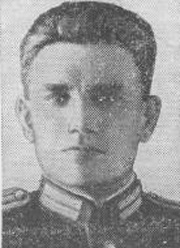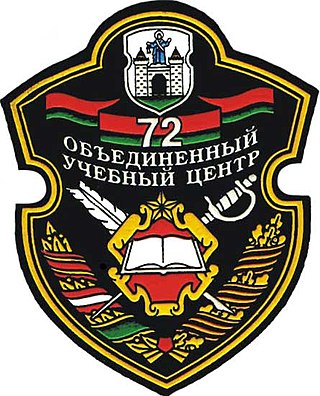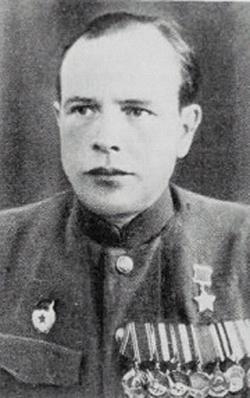
The 2nd Guards Tatsinskaya Tank Corps was a tank corps of the Soviet Union's Red Army that saw service during World War II on the Eastern Front of Europe. The unit's most notable moment was in the raid on Tatsinskaya during Operation Little Saturn in World War II. After the war, it continued to serve with the Soviet occupation forces in Central Europe. It was originally the 24th Tank Corps. The formation had approximately the same size and combat power as a Wehrmacht Panzer Division, and less than a British Armoured Division had during World War II.
The 75th Guards Rifle Division was a Red Army infantry division during World War II and afterwards, which later became the 75th Guards Tank Division and was finally disbanded in the 1990s.

The 3rd Guards Tank Army was a tank army established by the Soviet Union's Red Army during World War II. The 3rd Tank Army was created in 1942 and fought in the southern areas of the Soviet Union and Poland, then in Germany and Czechoslovakia until the defeat of Germany in 1945. Postwar, the army served as occupation troops in East Germany, went through several name changes, and was finally deactivated in 1969.
The 2nd Mechanised Corps was a formation in the Soviet Red Army during the Second World War.

The Northwestern Operational Command (SZOK) is a command of the Belarus Ground Forces. It is headquartered at Borisov and is commanded by Major General Alexander Volfovich. The command includes a mechanized brigade and a mixed artillery brigade. It was formed in 2001 from the 65th Army Corps.
The 46th Army was a Soviet Red Army field army during World War II. The army was formed in August 1941 and guarded the Turkish border. During the summer of 1942, it fought in the Battle of the Caucasus. During the spring of 1943, the army helped capture Maykop and Krasnodar. During the summer of 1943, it fought in the Donbass Strategic Offensive and the Battle of the Dnieper. During early 1944, it fought in the Nikopol–Krivoi Rog Offensive and the Odessa Offensive. During the summer it fought in the Second Jassy–Kishinev Offensive. The army advanced westward and participated in the Battle of Debrecen and Budapest Offensive during the fall. After the fall of Budapest in February 1945, the army fought in the Vienna Offensive and the Prague Offensive. During the summer of 1945, the army moved to the Odessa Military District and was disbanded in September.

The 19th Guards Mechanized Brigade is a formation of the Armed Forces of Belarus based in Zaslonovo, a few kilometers east of Lepiel. The brigade traces its history back to the 1942 formation of the 2nd Guards Mechanized Corps of the Soviet Army during World War II. Subsequent designations during the Cold War included 2nd Guards Mechanized Division and 19th Guards Tank Division. Following the Cold War, the 19th Guards Tank Division was relocated to Belarus and became part of their armed forces in 1992. Thereafter, the unit was reduced to a personnel and equipment cadre unit and titled the 19th Guards Base for Storage of Weapons and Equipment before being upgraded to a mechanized brigade in 2008.
The 5th Mechanised Corps was a mechanised corps of the Red Army, formed on three occasions. It was first formed in 1934 and was converted into the 15th Tank Corps in 1938. It was reformed in the Far East in 1940 and moved west before the German invasion of the Soviet Union. It fought in the First Battle of Smolensk, losing large numbers of tanks in the Lepel counterattack. The corps was encircled in the Smolensk pocket and after breaking out was disbanded in late August 1941. Its third formation, from elements of the 22nd Tank Corps, occurred in September 1942. The corps fought in: Operation Little Saturn, Operation Gallop, the Second Battle of Smolensk, the Dnieper–Carpathian Offensive, and the Second Jassy–Kishinev Offensive. In September 1944, it became the 9th Guards Mechanised Corps.
The 48th Army was a field army of the Soviet Red Army, active from 1941 to 1945. The army was first formed in August 1941 and fought in the Leningrad Strategic Defensive Operation. The army suffered heavy losses and was disbanded in early September. Its remnants were moved to the 54th Army. Reformed in April 1942 on the Bryansk Front, the army fought in the Maloarkhangelsk Offensive in the winter of 1943. It was sent to the Central Front in March and defended the northern face of the Kursk Bulge. During the summer, it fought in Operation Kutuzov and the Chernigov-Pripyat Offensive. From November, the army fought in the Gomel-Rechitsa Offensive. The army fought in Operation Bagration from June 1944. During the offensive, the army captured Zhlobin and Bobruisk and was on the Narew by early September. During early 1945, the army fought in the East Prussian Offensive and ended the war in East Prussia during May. The army was transferred to Poland in July 1945 and its headquarters was used to form the Kazan Military District in September.
Viktor Grigoryevich Zholudev was a Red Army major general and posthumous Hero of the Soviet Union. Zholudev fought in the 1929 Sino-Soviet conflict, the Battle of Lake Khasan in 1938 and the 1939 Battles of Khalkhin Gol, as well as World War II. Zholudev commanded the 37th Guards Rifle Division during its defense of the Stalingrad tractor factory during the Battle of Stalingrad.

Nikolai Nikolayevich Onoprienko was a Red Army colonel and World War II Hero of the Soviet Union. Onoprienko fought in the Battle of Smolensk, the Battle of Moscow, the Battle of Kursk, Operation Kutuzov, Operation Bagration, the East Prussian Offensive and the Berlin Offensive.

The 72nd Guards Joint Training Centre is a training centre of the Belarus Armed Forces. It trains warrant officers and junior specialists for the Belarus Armed Forces and is based in Borisov. The centre is currently led by Colonel Igor Korol. The 72nd Guards Joint Training Centre traces its history back to the Soviet 120th Rifle Division. For its actions during the Yelnya Offensive, the division became the 6th Guards Rifle Division in September 1941. In November 1945, the division became the 15th Guards Mechanized Division. On 15 May 1957, it became the 47th Guards Tank Division. The division became a training unit in 1960 and was renamed the 45th Guards Tank Training Division in 1965. In 1987, it became the 72nd Guards District Training Centre. In 1992, it was taken over by Belarus and became the 72nd Guards Joint Training Centre.

Alexander Petrovich Nikolayev was a Red Army senior lieutenant and Hero of the Soviet Union. He received the title Hero of the Soviet Union and the Order of Lenin for his actions during the Battle of Berlin. Nikolayev also fought in the Siege of Leningrad.
The 1st Guards Tank Division was a tank division of the Soviet Army from 1945 to 1947, stationed in Neuruppin. It was formed in the spring of 1942 as the 26th Tank Corps. The corps fought in Operation Uranus and became the 1st Guards Tank Corps, being redesignated as a reward for its actions in December 1942. It fought in Operation Gallop, the Third Battle of Kharkov, Operation Kutuzov, Operation Bagration, the East Prussian Offensive, the East Pomeranian Offensive and the Berlin Offensive. During the East Prussian Offensive, the division captured Mława, Działdowo and Płońsk and was awarded the Order of Lenin for its actions. The division had been awarded the honorific "Don" for its actions in Operation Gallop. It also was awarded the Order of the Red Banner and the Order of Suvorov 2nd class.
The 36th Guards Rifle Division was a Guards infantry division of the Red Army during World War II. It was formed from the 9th Airborne Corps in August 1942 as a result of the Soviet need for troops to fight in the Battle of Stalingrad. The division was awarded the honorific Verkhnedneprovsk for its crossing of the Dnieper in September 1943 near that town, later receiving the Order of the Red Banner and the Order of Suvorov, 2nd class, for its actions in the Uman–Botoșani Offensive in March 1944. It fought in the siege of Budapest during late 1944 and early 1945, receiving the Order of Kutuzov, 2nd class, for its actions. In late 1945, it was converted into the 24th Guards Mechanized Division. Stationed in Romania, it was disbanded in early 1947.
The 15th Guards Rifle Division was reformed as an elite infantry division of the Red Army in February, 1942, based on the 1st formation of the 136th Rifle Division, and served in that role until well after the end of the Great Patriotic War. The division had already distinguished itself during the Winter War with Finland in 1940 and had been decorated with the Order of Lenin; soon after its redesignation it also received its first Order of the Red Banner. It was in Southern Front as this time but was soon moved to the Reserve of the Supreme High Command where it was assigned to 7th Reserve Army in May, then to 28th Army in Southwestern Front in June, then to 57th Army in Stalingrad Front in July. It remained in that Army for the rest of the year, with one brief exception, until it was transferred to Don Front's 64th Army in January, 1943 during the closing stages of the battle of Stalingrad. In March this Army became 7th Guards Army and was railed to the northwest, joining Voronezh Front south of the Kursk salient. In the battle that followed the 15th Guards assisted in the defeat of Army Detachment Kempf, then took part in the summer offensive into Ukraine, winning one of the first battle honors at Kharkov. It remained in either 7th Guards or 37th Army into the spring of 1944. It saw action in the Nikopol-Krivoi Rog Offensive and was awarded the Order of Suvorov before being involved in the frustrating battles along the Dniestr River on the Romanian border. In June the division became part of 34th Guards Rifle Corps in 5th Guards Army and was redeployed north becoming part of 1st Ukrainian Front and taking part in the Lvov–Sandomierz Offensive into Poland. The 15th Guards made a spectacular advance across Poland during the Vistula-Oder Offensive and was further decorated with the Order of Kutuzov for forcing a crossing of the Oder River. It then saw action in the drive on Berlin in April and the Prague Offensive in May, winning a further battle honor and an unusual second Order of the Red Banner in the process. After the war the division did garrison duty in Austria, then in Ukraine, followed by a move in late 1947 to Crimea and the Kuban where its personnel assisted in rebuilding the local economy and infrastructure for nearly 20 years. It September 1965 it was renumbered as the "51st" and became the 2nd formation of the 51st Guards Motor Rifle Division.
The 33rd Guards Rifle Division was formed as an elite infantry division of the Red Army in May 1942, based on the 2nd formation of the 3rd Airborne Corps, and served in that role until after the end of the Great Patriotic War. It was the second of a series of ten Guards rifle divisions formed from airborne corps during the spring and summer of 1942. It was briefly assigned to the 47th Army in the North Caucasus Front but was soon moved to the Volga Military District and saw its first action as part of 62nd Army in the fighting on the approaches to Stalingrad. It was withdrawn east of the Volga in September, but returned to the front with the 2nd Guards Army in December, and it remained in this Army until early 1945. After helping to defeat Army Group Don's attempt to relieve the trapped 6th Army at Stalingrad the 33rd Guards joined in the pursuit across the southern Caucasus steppe until reaching the Mius River in early 1943. Through the rest of that year it fought through the southern sector of eastern Ukraine as part of Southern Front and in the spring of 1944 assisted in the liberation of the Crimea, earning a battle honor in the process. The Crimea was a strategic dead-end, so 2nd Guards Army was moved north to take part in the summer offensive through the Baltic states and to the border with Germany as part of 1st Baltic Front. During the offensive into East Prussia the division and its 13th Guards Rifle Corps was reassigned to 39th and the 43rd Armies before returning to 2nd Guards Army in April. For its part in the capture of the city-fortress of Königsberg the 33rd Guards would receive the Order of Suvorov. In mid-1946 it was converted to the 8th Separate Guards Rifle Brigade.
The 108th Guards Rifle Division was formed as an elite infantry division of the Red Army in July 1943, based on the 4th Guards Rifle Brigade and the 10th Guards Rifle Brigade and was the first of a small series of Guards divisions formed on a similar basis. It was considered a "sister" to the 109th Guards Rifle Division and they fought along much the same combat paths until the spring of 1945.
The 119th Guards Rifle Division was formed as an elite infantry division of the Red Army in September 1943, based on the 11th Guards Naval Rifle Brigade and the 15th Guards Naval Rifle Brigade and was one of a small series of Guards divisions formed on a similar basis. Although the two brigades had distinguished themselves in the fighting south of Stalingrad as part of 64th Army they were moved to Northwestern Front in the spring of 1943 before being reorganized. After serving briefly in 22nd Army the division was moved to reinforce the 3rd Shock Army within the large salient that Army had created behind German lines after a breakthrough at Nevel in October. In the following months it fought both to expand the salient and defend it against German counterattacks in a highly complex situation. In January 1944 it was transferred to the 7th Guards Rifle Corps of 10th Guards Army, still in the Nevel region, after which it advanced toward the Panther Line south of Lake Peipus. During operations in the Baltic states that summer and autumn the 119th Guards was awarded both a battle honor and the Order of the Red Banner for its operations in Latvia. In March 1945 it joined the Kurland Group of Forces of Leningrad Front on the Baltic coast containing the German forces encircled in northwest Latvia. Following the German surrender it was moved to Estonia where it was disbanded in 1946.
The 28th Tank Division was an armored division of the Red Army, created during the prewar buildup of forces in the Baltic Special Military District, based on a light tank brigade and a motorized rifle brigade, and fought against German Army Group North during the first months of Operation Barbarossa. It was initially under command of the 12th Mechanized Corps of 8th Army. It was noteworthy for being the first wartime command of Ivan Chernyakhovskii, who went on to lead the 3rd Belorussian Front. The division's tank regiments were largely destroyed in the first battles, but not without inflicting losses themselves, after which the remnants fell back through Latvia and Estonia, receiving enough reinforcements and replacements to remain combat-effective. It served well at Novgorod and in the early fighting around Demyansk, as part of 27th Army, but in November the Stavka ordered it to be converted to the 241st Rifle Division.









